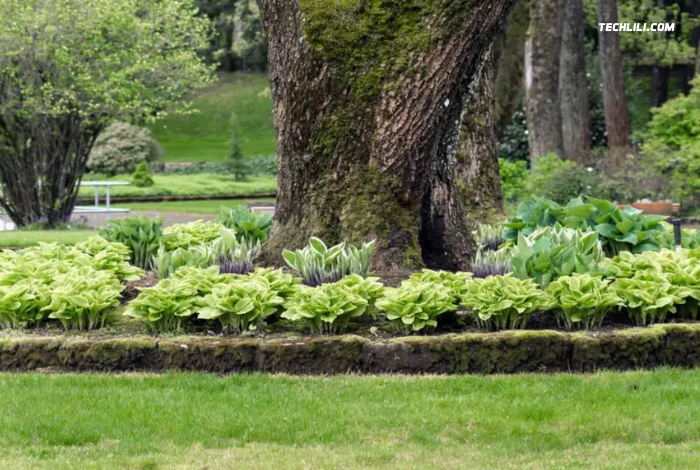Hostas Around Trees

Creating a captivating garden landscape involves a careful balance of color, texture, and form. One powerful way to achieve this balance is by strategically planting hostas around trees. Hostas, known for their vibrant foliage and adaptability, can transform the area around trees into a lush and inviting space. In this article, we will delve into the art of incorporating hostas around trees to enhance your garden’s aesthetic appeal and overall functionality.
The Appeal of Hostas
Hostas, often referred to as “plantain lilies,” are beloved by garden enthusiasts worldwide for several reasons. Their broad, decorative leaves come in a range of shapes, sizes, and shades, making them a versatile choice for various garden styles. From the classic deep greens to variegated and golden tones, hostas offer a rich palette that complements different plantings and adds depth to your garden.
Furthermore, hostas are known for their ability to thrive in various light conditions, making them well-suited for the understory environment created around trees. Their adaptability to shade makes them an excellent choice for adding interest to areas that receive limited direct sunlight.
Creating a Harmonious Understory
Planting hostas around trees offers an opportunity to transform an often-neglected space into a thriving garden zone. To create a harmonious understory, consider the following steps:
1. Assess Light Conditions
Before selecting hosta varieties, carefully evaluate the light conditions around the trees. While hostas tolerate shade, some varieties thrive better in partial shade or dappled sunlight. This assessment will help you choose hostas that will not only survive but also flourish in the designated area.
2. Choose the Right Hosta Varieties
Select hosta varieties that complement the existing trees and other plants in your garden. Consider factors such as leaf color, size, and texture. Hosta varieties with contrasting colors can create visual interest, while those with complementary shades can establish a more soothing atmosphere.
For instance, the classic dark green ‘Sum and Substance’ hosta can serve as a backdrop for lighter-hued flowers, while the variegated ‘Patriot’ hosta can add a touch of elegance and dimension.
3. Plan the Layout
Carefully plan the arrangement of hostas around the trees. Place taller hostas towards the back or center of the planting bed and shorter varieties towards the front. This layering technique ensures that each hosta gets its share of sunlight and visibility. Additionally, strategically placing hostas at different heights creates a dynamic visual effect.
4. Prepare the Soil
Hostas thrive in well-draining, rich soil. Prepare the soil around the trees by incorporating organic matter to improve drainage and fertility. Ensure that the soil remains consistently moist but not waterlogged, as excessive moisture can lead to root rot.
5. Consider Companion Plants
To enhance the beauty of your hosta planting, consider adding companion plants that thrive in similar conditions. Ferns, coral bells (Heuchera), and astilbes are excellent choices that can complement the lush foliage of hostas while adding diversity to the planting bed.
Benefits of Planting Hostas Around Trees
Beyond their visual appeal, incorporating hostas around trees offers several benefits that contribute to a vibrant and functional garden landscape:
1. Erosion Control
The dense foliage of hostas effectively prevents soil erosion, especially in sloped areas. Their spreading habit creates a natural ground cover that stabilizes the soil and reduces the risk of erosion caused by rainwater runoff.
2. Weed Suppression
Hostas’ ability to form a thick ground cover also aids in suppressing weed growth. By crowding out weeds and preventing them from receiving adequate sunlight, hostas reduce the need for excessive manual weeding or the use of chemical herbicides.
3. Temperature Regulation
The shade provided by the hostas’ lush foliage can help regulate the soil temperature around the trees. This is particularly beneficial during hot summer months when trees and their root systems can be susceptible to heat stress.
4. Biodiversity and Wildlife
Hostas around trees can attract a variety of wildlife to your garden. Birds, insects, and small mammals are drawn to the shelter and foraging opportunities provided by the dense foliage. This contributes to a more dynamic and ecologically balanced garden ecosystem.
5. Low Maintenance
Hostas are renowned for their low-maintenance nature, making them a practical choice for busy gardeners. Once established, they require minimal care and attention, allowing you to enjoy their beauty without the constant need for intervention.
Challenges and Solutions
While planting hostas around trees offers numerous advantages, there are also some challenges to consider:
1. Competition for Resources
Hostas planted around trees may have to compete with the tree’s root system for nutrients and water. To address this, ensure that you adequately prepare the soil with compost and maintain proper watering to support both the hostas and the trees.
2. Tree Canopy Limitations
In areas with dense tree canopies, the hostas might receive limited sunlight. To mitigate this, choose hosta varieties that are specifically suited to lower light conditions. Additionally, consider selective tree pruning to allow more dappled sunlight to reach the hostas.
3. Pest Management
Hostas can sometimes be susceptible to pests such as slugs and snails. To combat this, employ organic pest control methods like diatomaceous earth or set up beer traps to attract and eliminate these pests.
Conclusion
Planting hostas around trees offers a creative and rewarding approach to garden design. By carefully selecting hosta varieties, planning their layout, and considering the needs of both hostas and trees, you can create a harmonious understory that enriches your garden landscape.
The combination of color, texture, and practical benefits makes hostas a versatile choice for transforming the often overlooked area around trees into a thriving and visually captivating garden space. Whether you’re a seasoned gardener or a beginner, incorporating hostas around trees can be a delightful endeavor that enhances both the aesthetics and functionality of your outdoor haven.




